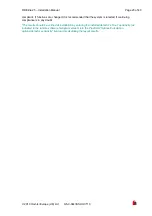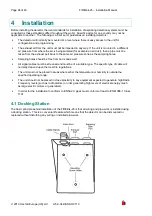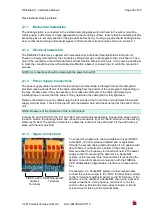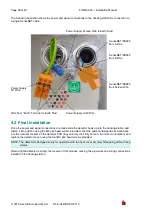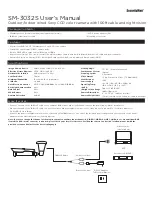
FIRElink-25 – Installation Manual
Page 37 of 40
©
2010 Hochiki Europe (UK) Ltd
9-5-0-344/ISS4/OCT10
9 Troubleshooting
9.1 Nuisance Alarms Occur Too Often
Check that the ClassiFire alarm factor setting is appropriate for the normal working environment of
the protected area. See section 2.2.4
Check that the detector is not in Demonstration mode. This can be ascertained by viewing the
event log (see section 2) and checking that the entry
Demo mode
has a higher log entry number
than the most recent
FastLearn start
and
FastLearn end
entries. Remember that the log entries
are in reverse order, with the most recent entries appearing first. If the log shows that
Demonstration mode was invoked during the last FastLearn period, start a new FastLearn and
allow it to complete its 24-hour cycle (see section 2.2.6).
From the event log (see section 6), check that 24 hours have elapsed since the last FastLearn end
entry.
Check that day-night switchover times are appropriately set to reflect active and non-active periods
(see section 2.3.1).
9.2 Elevated Smoke Levels Do Not Generate Alarms
Check that detector is not Isolated or in FastLearn (if Isolated, the Fault light will be lit)
Check that the detector sampling points are in the smoke stream
Check that the correct ClassiFire alarm setting has been set (see section 2.2.4)
Check that the detector has either had a 24 hour learning period or that it has been placed in
demonstration mode.
9.3 Low Mean Output
Check that the filter does not require changing (see section 2.8.3) and that the air plenum chamber
is clean. The chamber may become clogged when, for example, heavy building activity has
occurred near the sampling pipes. If so, the chamber may require factory service. The detector is
not designed to handle large quantities of coarse debris and dust.
9.4 Detector Sensitivity Varies Over Time
There are many reasons why particle densities may vary, and the ClassiFire system automatically
compensates for this in order to replace the likelihood of nuisance alarms due to normal variations
in background smoke density. Within limits set by the ClassiFire alarm factor, this is a normal part
of the detector‘s working.
9.5 Flow Fault Errors
These occur when the airflow rate into the detector is outside the pre-programmed limits. As the
detector ‘learns‘ the flow setup from the initial installation, this usually means that there has been
some change in conditions. A Flow high fault may indicate that a sampling pipe is damaged, and a
Flow low fault may indicate that the pipe has been blocked, for example, by nearby building
operations.
If the detector input is sampled from one area and the exhaust is in another area with different
pressure (for example the detector is in a roof space and sampling from an enclosed room), this
may lead to flow faults. In this case it would be necessary to lead a pipe from the exhaust to the

